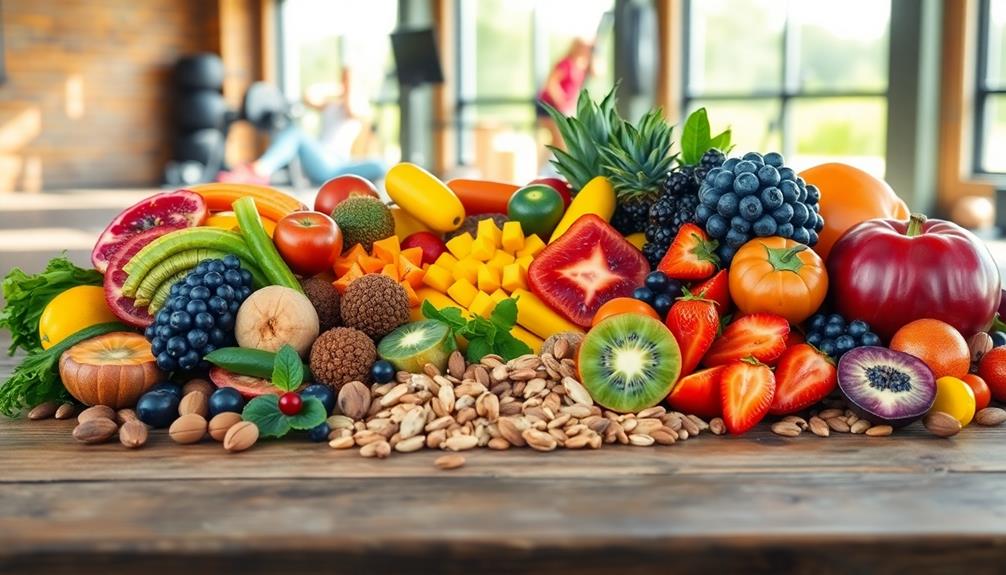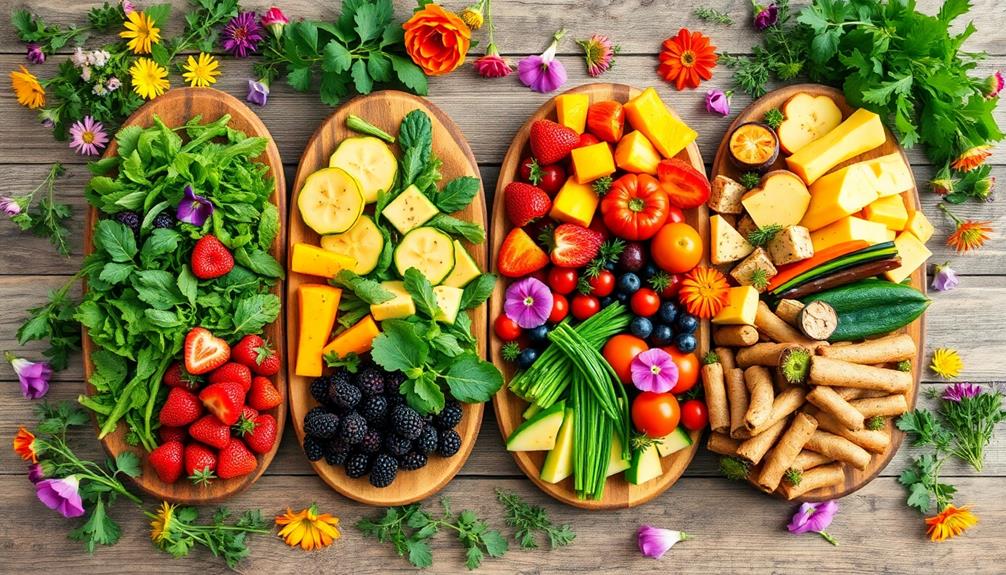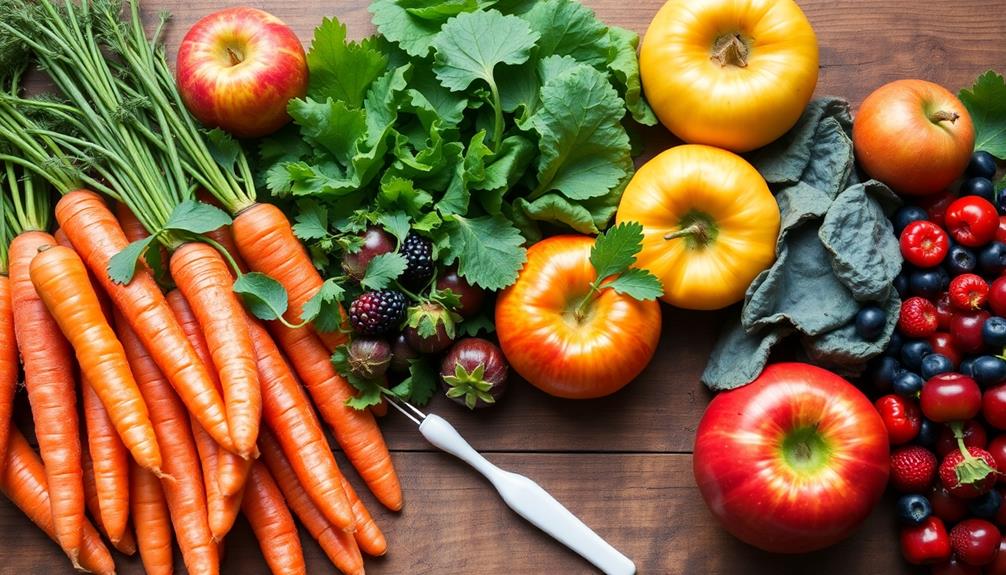If you're an athlete considering a raw food diet, you'll need to focus on meeting your specific nutritional needs. Start by ensuring you consume enough calories through energy-dense foods like nuts, seeds, and avocados. Prioritize diverse fruits and vegetables for crucial vitamins and minerals that support recovery and performance. Combine various plant-based protein sources to get all essential amino acids. Don't overlook food safety practices to minimize health risks. Regular evaluations of your intake will help identify any gaps. This approach can optimize your training and recovery, and there are many tips to make this change smoother for you.
Key Takeaways
- Professional guidance from registered dietitians is essential for creating tailored raw diet plans that meet athletes' unique nutritional needs.
- Athletes on a raw diet must focus on energy-dense foods to meet increased caloric requirements during competition.
- Incorporating a diverse array of colorful fruits, vegetables, and plant-based proteins ensures optimal nutrient density and essential amino acid intake.
- Regular evaluations of nutrient intake are critical to prevent deficiencies and maintain energy levels for athletic performance.
- Adhering to food safety practices, such as proper storage and avoiding cross-contamination, is vital for health on a raw food diet.
Importance of Professional Guidance

When diving into a raw food diet, it's vital to seek professional guidance to guarantee you're meeting your unique nutritional needs. Consulting with a registered dietitian or a nutritionist specializing in sports nutrition is essential for athletes like you.
These professionals can assess your dietary needs and help you shift smoothly to a raw food diet.
A tailored raw diet plan created by a registered dietitian can focus on your specific goals, such as enhancing muscle recovery, boosting energy levels, and improving overall performance. This individualized approach helps you avoid potential nutrient deficiencies.
Ongoing support from a nutrition professional allows for necessary adjustments to your raw diet based on performance feedback and any emerging nutritional concerns.
They can also educate you about the potential health risks associated with raw diets, including nutrient deficiencies and food safety issues.
Caloric Intake Considerations
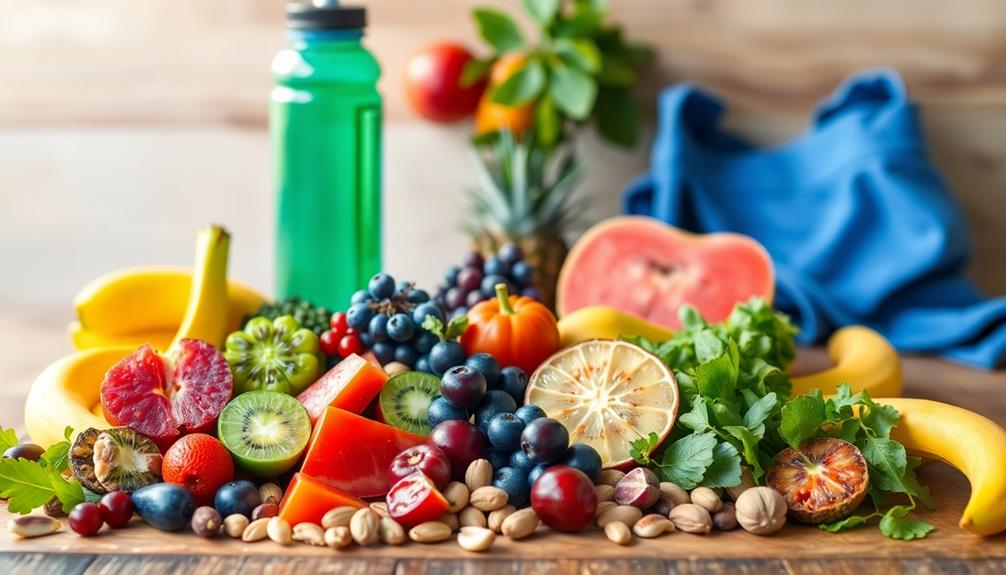
Professional guidance lays the groundwork for adopting a raw food diet, but once you've made the shift, managing your caloric intake becomes a top priority.
Raw diets can provide fewer calories than cooked options, which means you need to carefully monitor your energy levels to avoid deficits that could impede your performance. As an athlete, you often require a caloric increase of 20-50% during competition, and achieving this on a raw diet can be challenging without meticulous planning.
To maintain peak performance, you must focus on including energy-dense foods like nuts, seeds, and avocados in your nutrition. These foods not only help you meet your caloric intake but also support your energy needs.
Regularly evaluating your energy levels and gathering performance feedback is essential for ensuring you meet your personal energy requirements.
Nutrient Density Focus
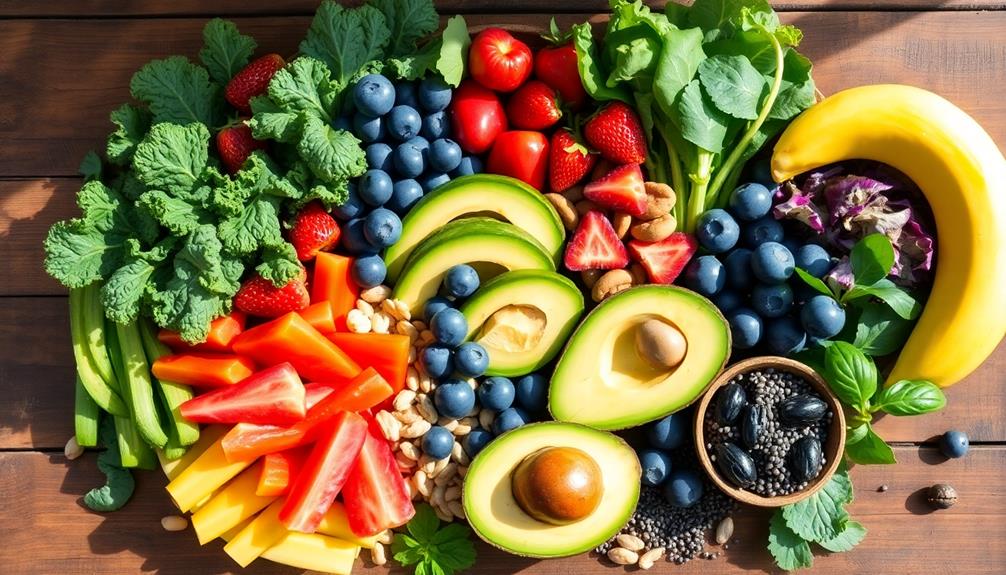
When you focus on nutrient density in your raw diet, it's vital to make diverse food choices that pack a punch in essential nutrients.
Prioritizing the right vitamins and minerals will support your athletic performance and recovery.
Regularly evaluating your intake helps guarantee you're meeting your nutritional needs without falling short.
Diverse Food Choices
A well-rounded raw food diet offers athletes a wealth of nutrient-dense options that can considerably enhance performance and recovery. By incorporating a diverse range of raw foods, you can guarantee that your body receives essential vitamins, minerals, and antioxidants crucial for peak athletic performance.
Furthermore, the inclusion of health benefits of tea can provide additional antioxidants that support overall health. Think about including colorful fruits and vegetables, as they not only boost nutrient density but also help reduce inflammation and increase energy levels during training.
To meet your protein needs, consider mixing different plant-based protein powders, nuts, seeds, and legumes. This variety helps you obtain all essential amino acids necessary for muscle repair and growth.
Regularly assess your nutrient intake to avoid deficiencies, especially since some nutrients in raw diets may be less bioavailable compared to cooked foods.
Essential Nutrient Prioritization
Focusing on nutrient prioritization in your raw food diet can greatly boost your athletic performance. By emphasizing a diverse array of plant-based foods, you can guarantee you meet your nutritional needs effectively.
To maximize your raw diet's benefits, consider the following essential nutrients:
- Vitamins A, C, and E: These vitamins are vital for immune function and reducing oxidative stress.
- Magnesium and Potassium: These minerals support muscle recovery and help prevent cramps during intense workouts.
- Sprouted Grains and Legumes: They enhance nutrient bioavailability, making essential nutrients more accessible for absorption.
Regular Intake Evaluation
To maintain ideal athletic performance on a raw food diet, regularly evaluating your nutrient intake is fundamental. This process helps guarantee you're meeting your energy and nutritional needs, especially since raw diets can sometimes lack sufficient calories.
Incorporate a diverse selection of fruits, vegetables, nuts, seeds, and legumes to provide a broad array of essential vitamins, minerals, and antioxidants critical for your performance.
Monitoring for potential nutrient deficiencies—such as protein, iron, and vitamin B12—is significant. Raw diets may limit the variety of protein sources available, so you need to be proactive in sourcing nutrient-dense options. Aim for a balance of macronutrients that supports your energy levels and aids recovery after training sessions.
Consider keeping a food diary to track your intake and identify any gaps. Regular consultations with a registered dietitian can further enhance your approach by tailoring your raw food intake based on your performance feedback and individual dietary needs.
Protein Source Awareness
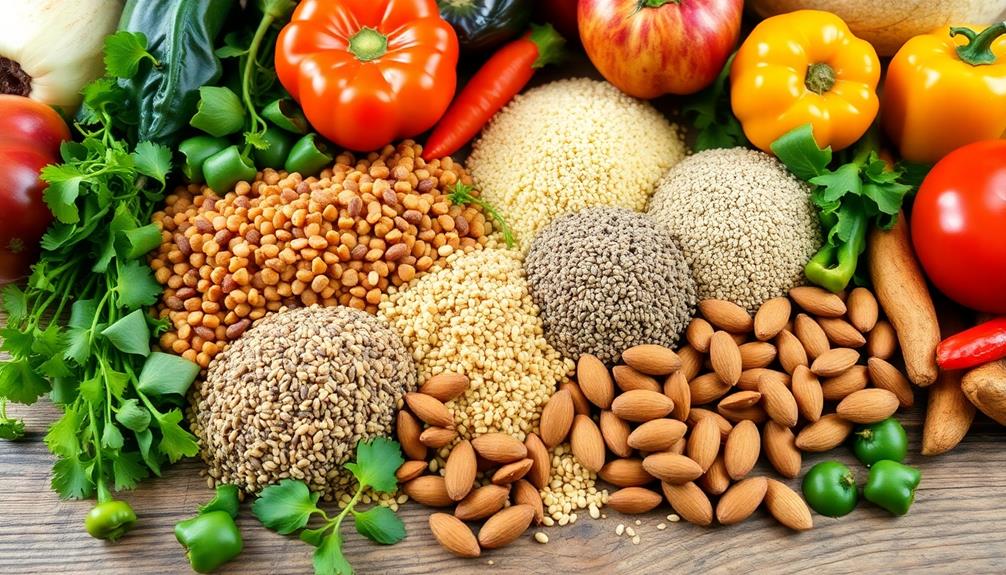
Understanding protein sources is important for athletes following a raw food diet, as they need to confirm their muscle repair and recovery needs are met. Proper protein intake is essential for maintaining muscle mass and supporting overall performance.
You can obtain adequate protein from various plant foods, but it's imperative to combine sources to make certain you're getting all essential amino acids. Additionally, incorporating benefits of raw food can enhance your overall health, providing the necessary nutrients and energy levels to support your training.
Consider including these key protein sources in your diet:
- Nuts and seeds: Great sources of healthy fats and protein.
- Legumes: Beans and lentils provide excellent protein, especially when paired with grains.
- Plant-based protein powders: Convenient for boosting your protein intake, especially post-workout.
As an athlete, your protein requirements generally exceed standard guidelines, often ranging from 1.2 to 2.0 grams per kilogram of body weight, depending on your activity level.
Regularly assess your protein sources and intake to avoid deficiencies that could hinder your performance. By being aware of your protein sources and confirming a varied diet, you can effectively meet your nutritional needs and support muscle repair while thriving on a raw food diet.
Food Safety Practices
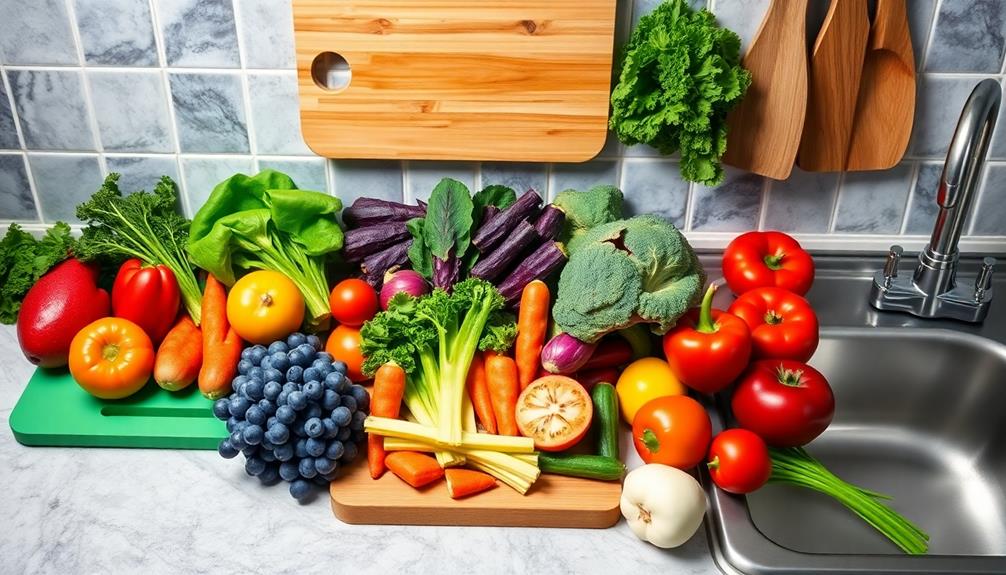
When you're enjoying a raw food diet, it's essential to prioritize food safety practices.
By using proper handling techniques, storing your ingredients correctly, and preventing cross-contamination, you can greatly reduce the risk of foodborne illnesses.
Let's explore how you can implement these essential safety measures in your kitchen.
Proper Food Handling Techniques
Proper food handling techniques are essential for anyone adopting a raw food diet, especially athletes who need to maintain peak performance. By ensuring proper sanitation and food safety practices, you can notably reduce the risk of foodborne illnesses.
Here are some key practices to keep in mind:
- Wash fresh produce thoroughly under running water to remove dirt, pesticides, and potential pathogens.
- Store perishables like fresh produce and nuts at appropriate refrigeration temperatures to prevent spoilage and maintain safety.
- Prevent cross-contamination by using separate cutting boards and utensils for raw foods versus cooked items.
It's also vital to regularly clean and sanitize kitchen surfaces, tools, and containers used for preparing raw food.
Always be mindful of the shelf life of your raw foods, consuming them before expiration dates to minimize the risk of foodborne illnesses associated with spoiled ingredients.
Safe Food Storage Methods
Effective food storage is vital for maintaining the safety and quality of your raw diet. To prevent foodborne illnesses, always keep perishable items, like raw fruits and vegetables, at temperatures below 40°F (4°C). Thoroughly wash these items before consumption and store them in clean containers to avoid contamination.
For nuts, seeds, and dried fruits, use airtight containers and place them in cool, dark places. This helps maintain freshness and prevents spoilage from exposure to air and light. Remember, it's important to check expiration dates regularly and discard any expired ingredients to guarantee you're consuming safe, nutritious food.
When preparing your meals, use separate cutting boards and utensils for raw foods. This practice reduces the risk of cross-contamination with cooked items, further protecting you from foodborne illnesses.
Preventing Cross-Contamination Risks
Maintaining strict hygiene practices is essential to prevent cross-contamination risks in your raw food diet. Adhering to food safety guidelines can greatly reduce the chances of foodborne illnesses linked to improper handling of perishable raw foods.
Follow these key practices to keep your meals safe:
- Always wash all fruits and vegetables thoroughly before consumption.
- Keep raw foods separate from cooked foods to avoid cross-contamination.
- Use separate cutting boards and utensils for raw foods and other items.
Proper food handling is vital, especially for athletes who rely on a healthy raw diet. Store perishable raw foods at temperatures below 40°F (4°C) to inhibit pathogen growth.
Regularly check and comply with food safety guidelines from reputable sources like the USDA or CDC, ensuring you stay informed about the best practices in the kitchen.
Raw Diet Benefits and Support
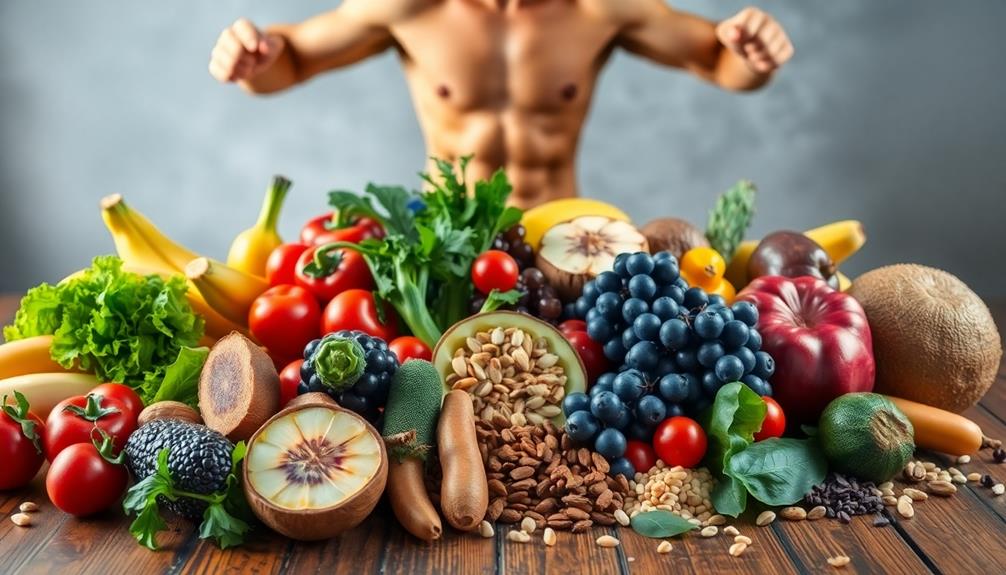
When embracing a raw food diet, you can experience a range of benefits that support both your health and athletic performance. This diet, rich in whole foods, emphasizes plant-based ingredients that provide essential nutrients. Studies have shown that a raw food diet can lead to higher levels of beta-carotene, lower blood pressure, and a reduced risk of chronic diseases like stroke and cancer. Clinical nutritionist Fred Bisci suggests that a 100% plant-based raw diet may even promote longevity, potentially extending lifespan considerably.
Here's a quick look at some key benefits of a raw food diet:
| Benefit | Description | Impact on Athletes |
|---|---|---|
| Nutrient Density | Preserves essential nutrients and enzymes | Supports energy and recovery |
| Lower Blood Pressure | High fruit and vegetable intake | Enhances cardiovascular health |
| Disease Prevention | Reduces risk of chronic diseases | Improves overall performance |
Adopting a raw food diet requires careful planning to meet your nutritional needs, especially as an athlete. By focusing on whole, unprocessed foods, you can harness the health benefits that raw food has to offer.
Processed Foods and Health Risks
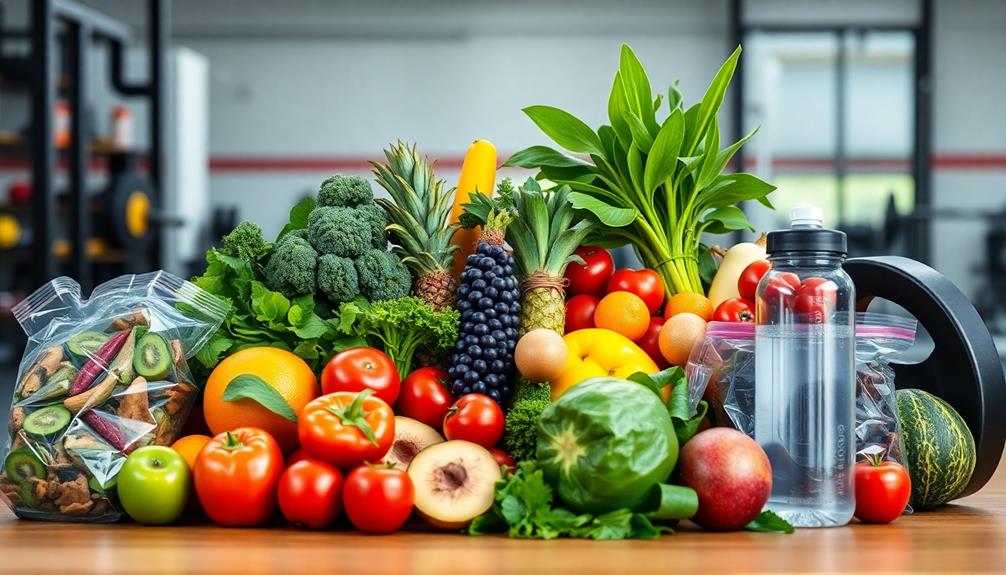
Steering through the landscape of nutrition can be intimidating, especially with the prevalence of processed foods that lurk in many diets.
As an athlete, you need to understand the significant health risks these foods pose. Processed items often contain harmful additives, preservatives, and excessive sugars that can derail your performance and recovery.
Consider the drawbacks of processed foods in your diet:
- They can lead to inflammation, hindering your training and competition outcomes.
- Many contain chemicals like xenoestrogens, which disrupt hormonal balance and overall health.
- Stimulants, such as alcohol and coffee, can negatively impact mental clarity and muscle recovery.
Transitioning to a Raw Diet
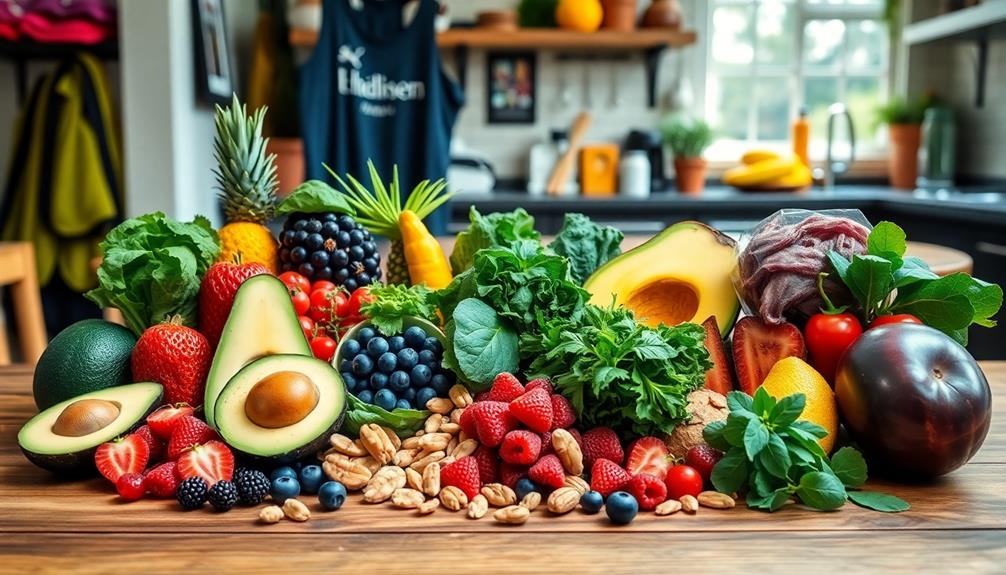
As you move away from processed foods, embracing a raw diet can greatly enhance your athletic performance and overall health. However, shifting to this diet requires commitment and patience. You might experience initial detox symptoms like fatigue and low energy, which can last up to six months. It's vital to stay focused during this adjustment period.
To meet your energy demands, increase your intake of fruits and starches, as raw diets tend to be lower in calories. Meal planning becomes essential; make sure your meals include a variety of nutrient-dense foods like fruits, vegetables, nuts, seeds, and sprouted grains. This planning will help you maintain a balanced nutritional intake.
Incorporating preparation methods such as blending, food processing, and dehydrating can enhance the flavor and variety of your raw meals, making it easier to stick with the diet.
Nutritional Strategies for Performance
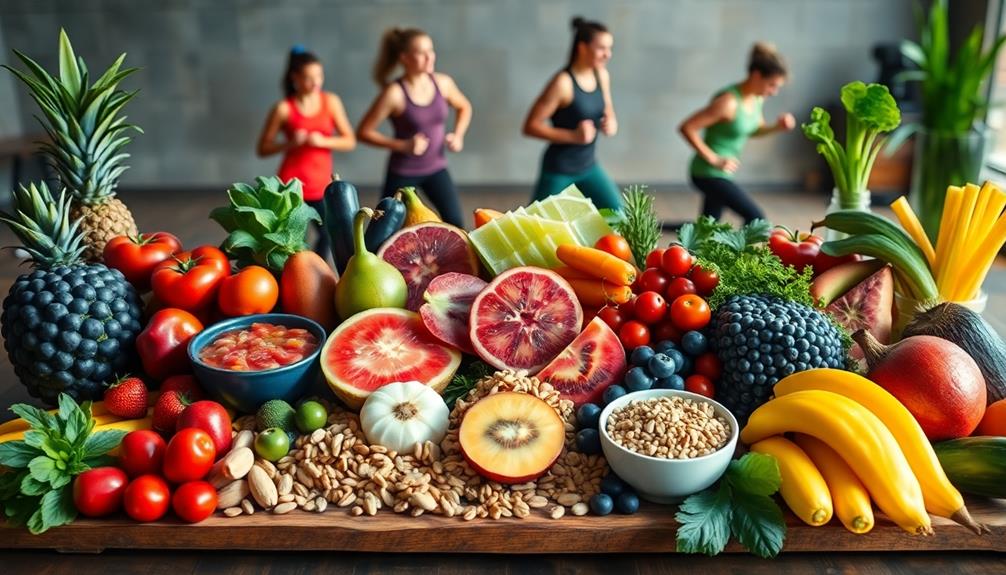
To maximize your athletic performance on a raw food diet, focusing on nutrient density is vital. You need to guarantee that you're consuming a diverse range of fruits, vegetables, nuts, seeds, and legumes to meet your essential nutritional needs.
Incorporating hydrating foods like fruits and vegetables can further enhance your performance by supporting hydration levels, which is critical for endurance athletes. Additionally, consider adding vitamins A, C, and K from foods like leafy greens and colorful vegetables to boost your nutrient intake.
Here are some effective nutritional strategies to keep in mind:
- Prioritize protein intake: Combine various plant-based sources like nuts, seeds, and legumes to guarantee you get all essential amino acids for muscle repair and recovery.
- Monitor caloric intake: Raw diets can be lower in calories, so adjust your consumption to meet your energy needs, especially during intense training or competition.
- Implement meal planning: Focus on whole foods that provide high energy, supporting both endurance and recovery.
Regularly evaluate your nutrient intake to prevent deficiencies, particularly for nutrients like B12, iron, and omega-3 fatty acids, which may require supplementation.
Achieving ideal nutrition through these strategies will enhance your athletic performance while adhering to a raw food lifestyle. Your dedication to meal planning and mindful eating will lead to sustained energy and improved recovery, making a significant difference in your training outcomes.
Frequently Asked Questions
How Can Athletes Meet Their Nutritional Needs?
To meet your nutritional needs, focus on a variety of nutrient-dense foods, track your caloric intake, guarantee adequate protein, and consider professional guidance to prevent deficiencies and tailor your diet for peak performance.
What Are the Best Natural Foods for Athletes?
Did you know that 70% of an athlete's performance hinges on nutrition? To boost your energy, focus on fruits, leafy greens, nuts, legumes, and sprouted grains. These foods fuel your body and enhance recovery effectively.
What Is the 80 20 Raw Food Diet Plan?
The 80/20 raw food diet plan encourages you to eat 80% raw, unprocessed foods and 20% cooked or processed options. This balance helps maximize nutrients while allowing for enjoyable meal variety and flexibility.
What Are Healthy Raw Foods?
Healthy raw foods include vibrant fruits like bananas and berries, leafy greens such as spinach, and nutritious nuts and seeds. Incorporating these into your diet boosts energy, supports recovery, and enhances overall wellness.
Conclusion
Incorporating a raw food diet can markedly boost your athletic performance, with studies showing that athletes consuming a plant-based diet can increase their endurance by up to 20%. By prioritizing nutrient density and being mindful of protein sources, you can meet your nutritional needs effectively. Just remember, shifting to a raw diet should be done thoughtfully, ideally with professional guidance. Embracing this lifestyle not only fuels your body but also supports overall health and wellness.

